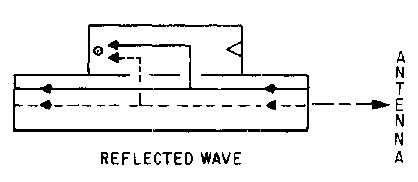1-43
the solid line. Because the waves are 180 degrees out of phase at the probe, they cancel each other and no
energy is induced in the pickup probe. When the reflected energy arrives at the absorbent material, it adds
and is absorbed by the material.
Figure 1-55.—Reflected wave in a directional coupler.
A directional coupler designed to sample reflected energy is shown in figure 1-56. The absorbent
material and the probe are in opposite positions from the directional coupler designed to sample the
incident energy. This positioning causes the two portions of the reflected energy to arrive at the probe in
phase, providing a sample of the reflected energy. The sampled transmitted energy, however, is absorbed
by the absorbent material.
Figure 1-56.—Directional coupler designed to sample reflected energy.
A simple bidirectional coupler for sampling both transmitted and reflected energy can be constructed
by mounting two directional couplers on opposite sides of a waveguide, as shown in figure 1-57.




